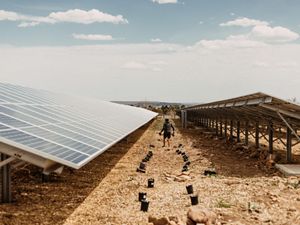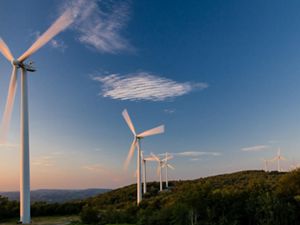
As Colorado builds out the renewable energy infrastructure needed to meet our climate targets, we must find creative solutions for siting renewables. One solution for land underneath solar arrays is called agrivoltaics: when agriculture and solar panels are located in the same place. This can provide ecological and community benefits alongside clean energy.

As part of an innovation initiative, TNC Colorado led a partnership to plant perennials under a half-acre solar array in Boulder. What made this project unique is that the solar array wasn’t originally designed to co-exist with agriculture. This was a pilot to demonstrate how agriculture can be integrated into existing solar infrastructure.
Partners included Jack’s Solar Garden, the largest commercially active agrivoltaics research site in the nation, and Drylands Agroecology Research (DAR), a regenerative agriculture collective. Their aim was to transform degraded, rocky soil into land that produces agricultural, ecological and cultural value for its neighbors. The solar array is owned by the City of Boulder and is dedicated to offsetting energy for low-income residents.
The team dug graded basins under the solar panels for water retention and brought in 150 cubic yards of compost and woodchips. They consulted with WishGarden Herbs and the University of Colorado’s Foundations for Leaders Organizing for Water and Sustainability (FLOWS) program to identify plants with medicinal and cultural values. The team also worked to foster relationships with the local community through volunteer planting days.
Traditionally, ground-mounted solar arrays are developed on bare ground or with gravel beneath them, with few benefits for ecological diversity or soil.
Quote: Nick DiDomenico Jr
If we can thoughtfully design these sites as ecological buffers, as habitat for insects and birds, and then also having viable crops ... that creates a huge opportunity for climate stabilization.

Plants help retain carbon and water in the ground, creating a positive cycle for richer soil and biodiversity. DAR planted all perennials so that the garden would not need to be replanted every year, but could passively provide herbs for years to come. The partners plan to collect data after the first growing season and refine strategies for future years.
The lessons and relationships from this pilot have already helped advance agrivolatics across the state. TNC supported a successful bill in the Colorado legislature, SB 23-092, that will channel $1 million towards agrivoltaics research and demonstration projects over two years.
Duncan Gilchrist, project lead and TNC’s Climate and Natural Resources Policy Associate, says the initiative shows that “with a small investment of time and money into an innovative solution combined with TNC's political heft, large-scale systems transformation is possible within a short period of time".










